It is always said that the history of humanity is the history of wars. And if we talk about wars we must necessarily talk about its protagonists, the most powerful Empires.
Historically, wars have occurred between empires, nations or countries. War is how a nation grows, whether in territory or in economic power.
The greatest empires of history were formed, expanded and maintained through war; and today we will learn which were the 32 largest empires in the history of the world

Largest Empires of the Ancient and Modern World
Contents
- Largest Empires of the Ancient and Modern World
- 1. British Empire
- 2. Roman Empire
- 3. Spanish Empire
- 4. Third German Reich (Nazi Germany)
- 5. Inca Empire
- 6. Soviet Empire (USSR)
- 7. Persian Empire
- 8. Greek Empire
- 9. Egyptian Empire
- 10. Mayan Empire
- 11. Portuguese Empire
- 12. Aztec Empire
- 13. Macedonian Empire
- 14. Napoleonic Empire
- 15. Chinese Empire
- 16. American Empire
- 17. Muslim Empire
- 18. Mongol Empire
- 19. Ottoman Empire
- 20. Mauryan Empire
- 21. Assyrian Empire
- 22. Swedish Empire
- 23. Russian Empire
- 24. Phoenician Empire
- 25. Japanese Empire
- 26. Holy Roman Empire
- 27. French Colonial Empire
- 28. Carthaginian Empire
- 29. Austro-Hungarian Empire
- 30. Hun Empire
- 31. Second German Reich
- 32. Carolingian Empire
1. British Empire
The British Empire covered the possessions, colonies, protectorates and other territories governed or administrated by the United Kingdom between the 16th and 20th Centuries. During the first decades of the 20th Century, the British Empire encompassed a population of close to 458 million people and some 33,000,000 km², which meant the fourth part of the world population and a fifth part of the drylands.
Its maximum splendor developed during the so-called Imperial Century (1815-1914), through a series of phases of expansion related to commerce, colonization, and conquest, in addition to periods of diplomatic activity. The empire facilitated the spread of British technology, trade, language, and government throughout the whole world. The imperial hegemony contributed to the spectacular economic growth of Great Britain and to the weight of its interests in the global scenario.

The British Empire was the largest empire in the history of humanity, as it was present on all the continents:
- In Asia, it ruled the territories of India, Pakistan, Sri Lanka, Burma, Malaysia, Borneo, and Hong Kong.
- In Africa, it controlled Egypt, Sudan, Zambia, Zimbabwe, Nigeria, Sierra Leone, Somalia, Uganda, Botswana, South Africa, Gambia, and some colonies in the east of the continent.
- In Oceania, it possessed the colonies of New Zealand and Australia.
- In the Americas, it controlled Canada, Jamaica, Guyana, the Falkland Islands, Belize, and multiple small islands.
- In the Mediterranean, it controlled strategic positions like Malta, Cyprus, and Gibraltar.
The economic cost of the 1st and 2nd World Wars and the transition of the colonies towards the Commonwealth gave rise to the end of the British Empire.
2. Roman Empire
The Roman Empire began in the year 27 B.C. when the title of Augustus was granted to Octavian. The Senate gave him the role of “Imperator,” “Father of the Country” and “Princeps Senatus.” He was considered the son of the deified Caesar and he was granted consular power in perpetuity. Under the maintenance of the republican forms, it slowly advanced towards a system of monarchical and militaristic power. This period is known by the name Upper Empire.

Later came four dynasties of emperors: that of the Julio-Claudians, that of the Flavians, that of the Antonines, and that of the Severans. All of them governed by a nearly absolute power based fundamentally on the army. The borders of the empire continued expanding, annexing Mauritania in the year 37, England in the year 84, and Dacia in the year 105.
During the reign of Augustus the civil wars were put to an end, and a time of order, security, and prosperity began, with great artistic and cultural flourishing, this stage being known as the “Pax Romana.” The maximum extension of the empire was reached with Trajan, who conquered the Parthians and in the year 117 conquered Armenia and Mesopotamia.
The different provinces incorporated into Roman rule were divided between senatorial and imperial provinces. The first were under the administration of the Senate. The second were under the control of the Emperor. There the legions were found. With the provincial power divided between the Emperor and the Senate, it is spoken of as a diarchy.
The most important city of the empire was Rome, its capital. In it, a great opulence was shown, where the members of the senatorial order and the rich gentlemen lived in the “Domus,” very luxurious residences, although the majority of the population lived in the “insulae,” tenement houses with as many as four floors, unsafe and uncomfortable.
With the death of Alexander in the year 235 the dynasty of the Severans ended and the empire was submerged in anarchy. The government was under the charge of military leaders who governed for a short time, followed by plenty of governors who in turn were overthrown by another more powerful military leader.

During the Lower Empire, the head of power was found a “Dominus,” a king with characteristics of divinity, began with Diocletian, who governed between the years 284 and 305, establishing the system of the tetrarchy and pacifying the territory. The empire was divided into a western zone, under his reign, and an eastern zone, under the charge of Maximian, each one choosing a Caesar.
After twenty years of government, the Augustus were replaced by the Caesars. They strengthened the bureaucracy and centralization, increased the number of provinces, and persecuted Christians ferociously, decreeing by an edict the obligation of imperial worship. Temples and books were destroyed and Christians suffered imprisonment and tortures.
In the year 395 Theodosius I divided the Empire between his two sons: Honorius, to whom the Western Empire with its capital in Rome belonged, and Arcadius, to whom belonged the Eastern, or Byzantine, Empire with its capital in Constantinople.
The decline of the empire began owing to the expenses originated in a bureaucratic and militarized state and to the pressure of the barbarian peoples crossing the imperial borders. In the year 476, the Western Roman Empire fell under the power of these peoples. That of the East, more economically solid, survived until 1453, the year in which Constantinople fell to the power of the Ottoman Turks.
3. Spanish Empire
“In Spain the sun never sets.”
This phrase pronounced by King Philip II captures the great expansion and the great power which the Spanish Empire achieved.
The Spanish Empire began to take shape in the epoch during which Isabella I of Castille and Ferdinand II of Aragon governed, the Catholic Monarchs whose matrimony in 1469 marked the beginning of the process of unification of their respective crowns. It was during the reign of the Catholic Kings that the new country began to raise an empire. This expansion overseas was due to various motives: on one hand, the monarchs wanted to secure their rule over the territories of North Africa and in this way protect Castillian commerce in the Mediterranean Sea and the Atlantic Ocean, in addition to using the neighboring areas as ports for the exportation of gold and African slaves; and on the other hand, they supported the exploration of remote places with the objective of expanding Christianity and increasing the potential trade of the two crowns in the Far East, which would supply great riches and international prestige.
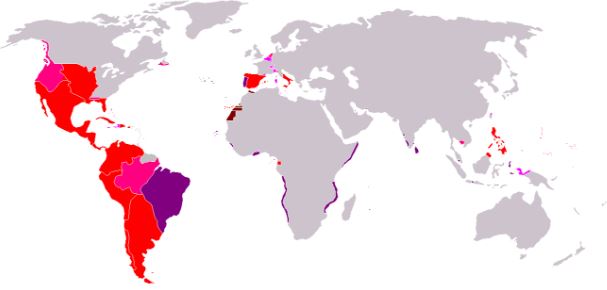
During the 16th and 17th Centuries Spain became the first world power. Castille, together with Portugal, was in the vanguard of European exploration and the opening of trade routes through the oceans. The Spanish Conquistadors discovered and dominated vast territories belonging to different cultures in America and other territories in Asia, Africa, and Oceania. Spain colonized these territories and with them constructed the greatest economic empire in the world.
Between 1648 and 1659, the peace of Westphalia and the Pyrenees ratified the beginning of the decline of Spain as a hegemonic power. This decline culminated, in that which respects the rule over European territories, with the Peace of Utrecht signed by Philip V in 1713: Spain renounced its territories in Italy and in the Low Countries, which entailed the loss of their hegemony in Europe. However, Spain maintained and widened its extensive empire overseas, harassed by British, French, and Dutch expansionism, until successive revolutions dispossessed them of their territories in the American continent at the beginning of the 19th Century.
Nevertheless, Spain conserved some fractions of its empire in America, mainly Cuba and Puerto Rico, as well as the Philippines and some islands in Oceania like Guam, Palau, the Caroline Islands, and the Marianas. The Spanish-American War of 1898 supposed the loss of nearly all these last territories. The moral impact of this defeat was tough, and they attempted to compensate for it by creating, with little success, a second colonial empire in Africa, centered in Morocco, Western Sahara, and Equatorial Guinea, which lasted until the decolonization in the decades of the 1960s and 1970s.
The Spanish Empire was the first global empire as, for the first time, an empire contained possessions on all of the continents.
4. Third German Reich (Nazi Germany)
The Third Reich makes reference to the Germany of the period contained between 1933 and 1945 when Adolf Hitler governed this country under the fundamentals of Nazism. This period was characterized by a strong imperialist and expansionist character.
The defeat suffered by Germany during the First World War brought extremely tough conditions for them, which were fixed in the Treaty of Versailles, by which Germany had to return territories and pay huge sums of money with the idea of compensation.
At the end of the war, the German Labor Party was founded, which in 1920 would take the name National Socialist German Worker’s Party, whose leader was Adolf Hitler. The model of the Nazi state was based on a dictatorship represented by the “Führer,” who would govern a nation of equals in race and thought, liberating Germany from the yoke imposed by the winners in the Treaty of Versailles.
With the crisis of 1929 unemployment and inflation increased gravely in Germany. The members of the Nazi Party gained more and more followers, obtaining 37.4% of the votes in the elections of 1932. Hitler had not only local support but also that of the western states, like England and France, who saw him as an effective weapon in the fight against communism which threatened to expand from Russia. In 1933 Hitler became Chancellor. He dissolved the Parliament, prohibited freedom of the press and unions, and established a system of only one party: the Nazi party. To finish off the opposition he created the SS and the Gestapo, bodies of police intended to destroy all ideology contrary to Nazism.

On the death of president Hindenburg, Hitler became the Führer or “conductor”. He united under his person all powers, giving rise to a type of state known as the Third Reich, with a strong intervention from the government. Under his government, Germany strengthened itself economically, giving impetus to public works, which motivated the massive support of the population, motivated by a strong propaganda policy by means of the radio and theater. Hitler came to power with the popular vote, but later systematically suppressed democracy.
Another characteristic of the Third Reich was imperialism. Its deep expansionist desire was expressed in its incorporation of Austria in 1938, Czechoslovakia in 1939 and the invasion of Poland in the same year, beginning World War II. The Nazi regime fell in 1945 with the end of the war.
5. Inca Empire
The Incas were a conquering people who achieved the occupation of a great territorial expanse: from the mountains in the south of modern Colombia to the north of Chile and Argentina, and from the coast of the Pacific Ocean to the east of the Amazon River valley, thus constituting a powerful empire, in approximately the year 1430, which they called Tahuantisuyo, which means “the four parts of the world,” as it was divided into four regions. The capital of the empire was Cuzco, situated at 3,400 meters above sea level. Its economy was fundamentally agricultural and they invented a curious technique of cultivation, called terracing, which consisted of building terraces on the slopes of the mountains, in which they farmed.

From the conquered peoples they obtained important incomes by means of tributes and they adopted their cultural characteristics. Among the conquered peoples was the Chapín culture, located in the north of Peru, which had acquired a wide knowledge of agriculture, astrology, and engineering; the Mochicas and the Chimu, settled on the north coast of Peru dedicated themselves to agriculture and livestock: on the south coast were the Nazca, fundamentally dedicated to ceramics and to agriculture irrigated by canals; in Bolivia they conquered the Tiahuanaco and the Huari, militaristic societies who also had a great degree of agricultural, architectural, and artistic development.
The highest imperial authority was the Inca, considered to be the son of the sun, who had absolute powers, in a system of government which was a theocratic monarchy. The first Inca was Manco Capac and the last, of a total of thirteen, was Atahualpa, whose power was destroyed by the Spanish conquest in the year 1533. The Spanish conquest ended their cultural development and imposed the way of life and the religion of the Conquistadors.
6. Soviet Empire (USSR)
The Union of Soviet Socialist Republics (USSR) was a constitutional confederation of socialist states based on the communist ideology which existed in Eurasia from 1922 until 1991.
The USSR was born as a union of four Soviet socialist republics, formed inside the territory of the extinct Russian Empire, but it later grew to fifteen: Armenia, Azerbaijan, Belarus, Estonia, Georgia, Kazakhstan, Kyrgyzstan, Latvia, Lithuania, Moldova, Russia, Tajikistan, Turkmenistan, Ukraine, and Uzbekistan.
From 1945 until 1991, in the period known as the Cold War, the Soviet Union was one of the world superpowers which dominated the global agenda of economic policy, foreign affairs, military operations, cultural exchange, scientific progress, etc. The Soviet Union came to be the model of reference for future socialist states during the Cold War. The government and political organization of the country were defined by a one-party regime, the Communist Party of the Soviet Union (CPSU).

The beginning of the end of the USSR began in the decade of the eighties. This was characterized by the collapse of the economic and political structures of the State. With the arrival of Gorbachev to power in 1985 significant changes were produced in the economy. In addition, public access to information was permitted after decades of strong censorship, an act which provoked a great worldwide repercussion and which gave a glimpse of the future that awaited the Soviet Union.
At the end of the eighties, the republics which composed the Soviet Union legally incorporated movements towards the declaration of sovereignty over their territories. Finally, the 8th of December of 1991, the presidents of Russia, Ukraine, and Belarus signed the Belavezha Accords in which the dissolution of the Soviet Union was officially declared.
7. Persian Empire
The Persians were a people of Indo-European language who originated as a group of nomadic tribes whose original location lay in the north of the plateau of Iran. Around the year 1400 B.C., some of these tribes moved towards the south of Iran and established their capital at Susa, together with the Medes, a nation which dominated them. This situation continued until the middle of the 6th Century B.C. when the king Cyrus II the Great defeated the Medes and submitted them to his authority. He laid the bases of a new empire by conquering Lydia, the Greek colonies of Asia Minor, and Mesopotamia.
The government was in the charge of an absolute monarch. The territory was divided into 20 satrapies, the most important being those of Lydia, Media, Assyria, Babylonia, Egypt, and India, which shows the great expansion which this empire reached. The religious capital was Persepolis, and the three administrative capitals were Susa, Ecbatana, and Pasargadae. In all these places important palaces were erected in order to honor the sovereign.
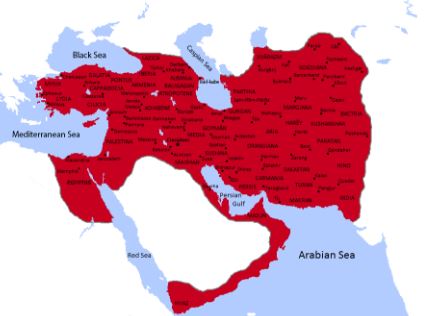
They had a powerful army, in which the royal guard stood out, made up of ten thousand men, know as the “Immortals,” who carried out the defense of the territory and the conquest of other new lands, but with a respectful attitude towards the dominated peoples, to whom they gave recognition of their cultural identity. The Persians felt awe for the phenomena of nature and worshiped them as gods, although they later created a new religion, Zoroastrianism.
This empire was weakened after losing the Greco-Persian Wars against the Greeks and was later reduced and conquered by Alexander the Great, finally passing into the hands of the Roman Empire.
8. Greek Empire

At the beginning of the annals of Greece are found the heroic times, the war of Troy and more, but later there was a period of transition in which, little by little, Greek populations were established in military and commercial cities. With the wars of Mycenae, Sparta was able to establish its hegemony over all of the Peloponnese, while the maritime cities searched for expansion on the coasts of the Mediterranean and founded flourishing colonies, not only in Asia Minor, but also in Africa, Spain, and Italy. Athens, meanwhile, was distinguished for its wise laws, for its maritime and commercial power, and for its literary culture.
At the end of the 11th Century B.C., Athens and Sparta, the two principal states of Greece, considered themselves rivals. The Greco-Persian Wars united them against the Persians. The Greeks were able to save Hellenic independence and the civilization of Europe. Their victories had contributed to the enlargement of Athens and this city had become the center of a colonial empire which extended throughout the Aegean Sea and the Propontis, and later with Pericles, it reached its golden age, coming to be the center of all of the Hellenic civilization.
With the Greeks weakened by internal fights, the neighboring kingdom of Macedonia began to acquire importance and in the end, Philip II imposed Macedonian unity in Greece. The end of the Greek empire came in the year 338 B.C.
9. Egyptian Empire
The Egyptian Empire spans from the year 3100 B.C. to 31 B.C. and is divided in three periods: the Old Kingdom, the Middle Kingdom, and the New Kingdom.
The Old Kingdom began with the unification of Upper and Lower Egypt by Narmer around the year 3100 B.C. and lasted approximately 500 years. Narmer and his successors founded a society divided in social strata and in which a divine ancestry was attributed to the Pharaoh. Its capital was situated in Memphis. This was the era of the pyramids, during which the Pharaohs had enormous power. At the end of the Old Kingdom power in, Egypt began decentralizing and various “principalities” were formed, and Egypt came to have two capitals, Thebes and Herakleopolis. This situation was maintained until the Thebans defeated the Pharaohs of Herakleopolis and Thebes came to be the only capital.

The Middle Kingdom began with the reign of Mentuhotep II. This meant a return to normalcy and to prosperity for Egypt. It advanced in all fields: in the arts, in the construction of temples and tombs, in the conquest of territories, in carrying out expeditions to Asia, in improving the agricultural areas, etc. This was an imperialist era.
The pharaohs adopted a centralized power with a large bureaucracy formed by the Hyksos, nomads who came from the Asiatic steppes and who established themselves in the Nile Delta. Their integration was so complete that in the year 1650 B.C. they took advantage of the political instability to rise to power, with which they would end the Middle Kingdom. In Thebes there remained strongholds of resistance against the Hyksos. Ahmose, Prince of Thebes, expelled them from power in Egypt, with which the New Kingdom began.
Under the New Kingdom the borders, the objectives, and the bureaucracy of the Middle Kingdom were reestablished, and its program of making use of the land was reactivated. With the reign of Thutmose I Egypt reached its greatest expansion: in the north it reached to the Euphrates and towards the south to the fourth waterfall of the Nile.
In the year 332 B.C. the conquest of Egypt by Alexander the Great began. In 305 the Ptolemaic dynasty came to power. In 31 the incorporation of Egypt into the Roman Empire occurred after the battle of Actium. One year later Cleopatra died and Egypt became a province of the Roman Empire.
10. Mayan Empire
The Maya civilization inhabited a vast region denominated Mesoamerica, situated to the southeast of Mexico. This civilization has a history of approximately 3,000 years, throughout which it founded a great empire.

The Maya society was organized on the basis of a marked social stratification, at the head of which was found the nobility, the “almenehoob.” This privileged group monopolized power and authority by occupying the political and religious posts. The supreme governor of the province was the Halach Uinik, in whom resided absolute power over earthly and spiritual matters.
Dominating the majority of the aspects of life for the Maya was found their religion (polytheistic), always present and letting its influence be felt in their agricultural rites, in public ceremonies, in art and in their culture.
This is one of the most important Pre-Columbian Mesoamerican cultures, as its scientific and astronomical legacy is worldwide. Agriculture was the central activity in the lives of these people and trade was indispensable for the economy, as the Maya geographical area provided great produce, but limited others. Money for trade did not exist, only barter. The destruction of Mayapan, sixty years before the arrival of the Spanish, marked the beginning of the end of this empire.
11. Portuguese Empire
The Portuguese Empire was an empire which stood out in the 15th, 16th, and 17th Centuries. It all began by traveling to lands unknown to the Europeans and giving rise to the “Age of Discovery.” The Portuguese arrived first to India and to South Africa, and later they expanded, arriving in America, the south of Asia, and all the coasts of Africa. This empire, above all during its beginnings, was structured on:
- The strictly speaking Portuguese cities.
- The factories in non-Portuguese cities built exclusively for trade.
- The bases or zones of direct exchange (non-Portuguese cities without buildings whose trade was carried out from the holds of the ships themselves).

The Portuguese Empire came to belong to the Spanish Monarchy during the reign of Philip II and was separated during the reign of Philip IV (1580-1640).
12. Aztec Empire
The Aztecs were natives of Aztlan, which means “land of herons,” the place from which they emigrated towards the south in the year 1168 together with six other tribes of the same race, on whose route they fought with other peoples, which strengthened their warrior spirit, until they settled on an island in Lake Texcoco, founding their capital in 1325, Tenochtitlan, which means “place of the moon.”
Having been subjected by the Tepanecs, they managed to defeat them after a century of harassment, under the reign of Itzcoatl, assuming for themselves the role of the conquering people of other neighbors, who they forced to pay tribute. The Aztec Empire arose from the confederation of three kingdoms located in the valley of Mexico: Tenochtitlan, Texcoco, and Tlacopan.

The highest political authority, which would rise by election by a supreme council made up of nobles, was the “Huey Tlatoani,” selected from among the close relatives of the deceased monarch, who had judicial, political, and religious functions.
It was an agricultural society which used developed techniques of cultivation, like clearing, which consisted of chopping down the trees of a jungle area in order to then burn them and be able to grow things in that space, using the ashes as fertilizer. In the mountainous zones, like the Inca, they used the system of terraces, consisting of building narrow fertilized steps on the mountainsides with the purpose of retaining moisture.
Their most important artistic manifestations were expressed in poetry, music, and dance. In their poems they reflected the profound distress which filled their conception of the world, as they conceived of life as an illusion, beyond which existed a paradise, Tlalocan, and a hell, Mictlan. They worshiped various gods. The Spanish conquest in the year 1521 put an end to the empire.
13. Macedonian Empire
The Kingdom of Macedonia was a state in Classical Antiquity situated in the north of modern Greece. This kingdom was consolidated during the 5th Century B.C. and experienced an important ascent of its power during the 4th Century B.C. with the governance of Philip II, who converted Macedonia into a great power. His son Alexander the Great continued his labor and conquered the greater part of the known world.
Alexander the Great, with the same expansionist ideas as his father, subdued the Greek cities lead by Athens and Thebes. He gave himself the name “Hegemon,” a title which his father had already held and which situated him as governor of all Greece.

With the Macedonian hegemony thus consolidated, Alexander prepared himself to complete the last project of his father Philip II, conquering the Persian Empire. Alexander conquered it, including Anatolia, Syria, Phoenicia, Judea, Gaza, Egypt, Bactria, and Mesopotamia, and expanded the borders of his own empire as far as the region of Punjab. Before his death, Alexander had made plans to turn towards the west and conquer Europe.
During the next 20 years there was nothing but internal fights. In the end, the empire was divided and the glorious Macedonian Empire came to an end.
14. Napoleonic Empire
The Napoleonic Empire is contained between 1799, the year in which Napoleon became Consul by means of a coup d’état, and 1815, the year in which the Bourbon monarchy was restored in France.

The exterior campaigns during the French Revolution introduced to the French people the figure of a young general who would provide successes and on whom they would deposit their hopes in times of anxiety and instability, Napoleon Bonaparte. Elected as consul in the beginning, in little time he would gather in his hands sufficient power to install an imperial regime and initiate a process of territorial expansion through which France would come to control a good deal of Europe.
The hegemonic position of France was contested by some nations, principally Great Britain, who were suspicious of the unmeasured accumulation of power by only one nation and of their expansionist longings. In reply, Napoleon imposed a continental blockade on trade with English products. An alliance of nations created to slow French expansionism would lead to a war of European scale and, finally, to the military defeat of the Emperor and his removal from power.
15. Chinese Empire
In the year 221 B.C. Qin Shi Huang, of the Qin Dynasty, proclaimed himself Emperor of China. With the help of a minister, Li Si, the Emperor unified the mosaic of feudal states into an administratively centralized and culturally unified empire. Hereditary aristocracies were abolished and their territories were divided into provinces governed by bureaucrats named by the Emperor. A system of writing was adopted and its use was made obligatory in the whole empire. In order to promote internal commerce and economic integration, the Qin rulers unified the weights and measures and the minting of coins. Private property of lands was adopted and laws and taxes were applied equally.
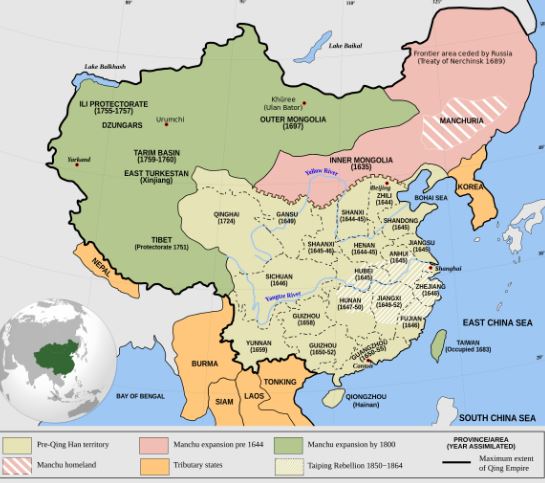
The first emperor also tried to expand the exterior borders of China. In the south, his armies marched towards the delta of the Red River, which is in present-day Vietnam. In the southwest, his dominion extended to encompass the greater part of the current provinces of Yunnan, Guizhou, and Sichuan. In the northwest, his conquests reached Lanzhou, in the current province of Gansu and in the northeast, a sector of what is today Korea recognized the superiority of the Qin. The center of Chinese civilization, however, remained in the valley of Huang He. In addition to the unification and expansion of the empire, the best known achievement of the Qin dynasty was the completion of the Great Wall of China.
16. American Empire
American Imperialism makes reference to the historic expansionism and to the current political, cultural, military, and economic influence of the United States on the world scale. The American Empire has successfully expanded due to its military activities.
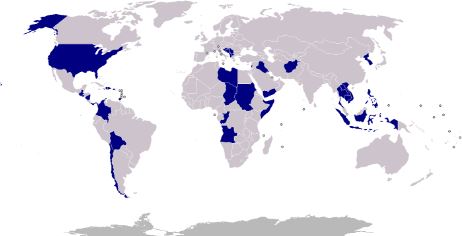
According to diverse sources, the government of the United States has overthrown or tried to overthrow numerous foreign governments perceived as hostile. It practiced this policy through the direct participation of American agents, the financing and formation of insurgent groups inside these countries, propaganda campaigns, coup d’états, fraudulent elections, and other activities, generally carried out by the CIA.
The United States has military bases distributed throughout the world and exercises governmental control over those nations which are less developed and have fewer means, as happens or happened with Ukraine, Georgia, Kyrgyzstan, Nicaragua, El Salvador, etc.
17. Muslim Empire
The precepts indicated in Islam were the basis for the beginning of Arabic expansion. The obligation of believers to practice the Holy War in defense of the faith favored the incorporation of soldiers into Arabic armies and ceasing to fight among themselves.
There were also other reasons which drove Arabic expansion. From the economic point of view, the poverty of the land inhabited by this people pushed the search for more fertile and prosperous lands. To this was added the gradual decline of the Persian and Byzantine Empires, a favorable condition for the introduction of this new culture.

On the death of Muhammad in the year 632, his successors, denominated Caliphs, were charged with directing the Islamic people and procuring the expansion of the religion and of the territory. In the 7th and 8th Centuries, the Muslims were able to expand their empire, taking control of territories which spanned from the Iberian Peninsula to India.
After several centuries of existence and expansion, at the beginning of the 13th Century a great threat loomed over Islam. The Mongols, who invaded Baghdad in 1258, had conquered the majority of the Islamic territories to the east of Egypt. The hordes ended the Golden Age of medieval Islam, leaving the Islamic world ruined and confused. Later, the Mongols would convert to Islam and developed their own culture, integrating elements from every corner of Eurasia.
18. Mongol Empire
The Mongol Empire was the empire with the most extensive continuous lands in history. At its height, it extended from the Korean peninsula to the river Danube.

Starting in the year 1206, the Mongol tribes united under the command of Genghis Khan and the empire came to have a maximum expanse of 33 million square kilometers and more than 100 million inhabitants, including some of the most advanced and populated nations of the time, like China, Iraq, Iran, and the countries of Central Asia and Asia Minor. The army of Genghis Khan, in spite of being relatively small numerically, had a well-prepared cavalry, expert archers, and discipline among its leaders.
The decay of the Mongol Empire in the 14th Century occurred because of diverse factors:
- Tribal rivalry and crises of succession.
- Assimilation of the conquered cultures.
- Antiquated military model.
- Development of agriculture and shortage of military forces.
- Use of gunpowder: the use of gunpowder in firearms changed the way war was made, and made obsolete the use of cavalry troops, the forte of the Mongols.
19. Ottoman Empire
The Ottoman Empire began as one of the small Turkish states which arose in Asia Minor during the decay of the Seleucid Empire. The Ottoman Turks began gradually controlling the other Turkish states. Bursa fell in their hands in 1326 and Adrianople in 1361. The Ottoman victories in the Balkans alerted Europe to the danger which this empire represented and were the central motive for the organization of the First Crusade.

The empire saw a dizzying expansion: it defeated Wladyslaw of Poland in 1444 and captured Constantinople in 1453. In this way, the Ottomans had gone from being a nomadic horde to becoming one of the most extensive and splendorous empires in the world. Later the expansion of the empire towards Hungary, Wallachia, Moldova, and Transylvania took place. Part of the secret of their triumph resided in the possession of a powerful army made up of strict hierarchies to which Christians and foreigners could belong. Their elite body was made up of the famous Janissaries or European soldiers who had been taken as children and reeducated in Islam. The Ottoman Empire also expanded its borders into the north of Africa.
When the First World War broke out, the Ottoman Empire allied itself with Germany and the Triple Alliance. After the defeat of the Central Empires, the Ottoman Empire collapsed into disorder. In 1918 the Turkish resistance collapsed equally in Asia and in Europe, concluding with an armistice and the definitive fall of the Ottoman Empire, dissolved with the signing of the Treaty of Sevres.
20. Mauryan Empire
The Mauryan Empire was the first great unified empire in India. Ruled by the Mauryan dynasty, it lasted from 320 B.C. until 185 B.C. During its existence, the people enjoyed an era of social harmony, religious transformation, and the extension of the sciences and knowledge.
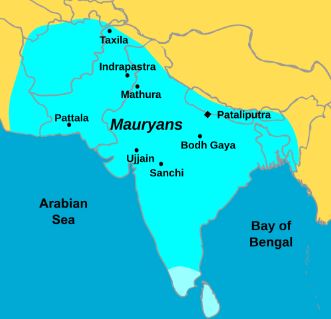
The empire expanded towards the north along the natural borders of the Himalayas and to the east towards the current state of Assam. To the west, it reached beyond Pakistan. The Empire was enlarged in the central regions and towards the south of India by the emperor Bindusara. Its decay began 50 years after the death of Ashoka and it dissolved in the year 185 B.C. with the foundation of the Shunga dynasty in Magadha.
21. Assyrian Empire
In the region of the Upper Tigris, to the north of Mesopotamia, lived the Assyrians, a Semitic and warlike people who were able to become independent around the year 1600 B.C. They established their capital in Assur, after coming to an agreement with the Kassites of Babylonia about the borders of the new state. The king had absolute power and his authority acknowledged a divine origin.
The Assyrians and the Kassites were related by the marriage of an Assyrian princess with the Kassite governor of Babylon, whose son was assassinated. The Assyrians took advantage of the occasion to stamp out the internal disorder in Babylon and take power, which lasted until the death of the conquering sovereign. Soon they began a process of expansion which transformed their domains into a great empire beginning in the 8th Century B.C., conquering Syria, Phoenicia, Palestine, Egypt, Babylonia, and the south of Mesopotamia.

Utilizing terror as a weapon of war, the Assyrians sowed desolation and panic among the conquered peoples, some of whose members were deported to other areas of the empire in order to impede rebellions, bringing as a result the fusion or the disintegration of cultures.
The end of Assyrian dominion occurred when the Chaldeans, allied with the Medes, attacked and destroyed the city of Nineveh in the year 612 B.C.
22. Swedish Empire
Sweden was one of the great European powers of the 17th Century. This era is known as that of the Swedish Empire, “The era of great power.”
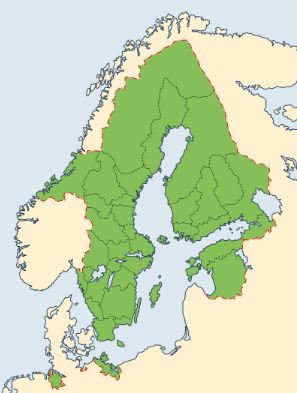
At the conclusion of the Thirty Years’ War, the Peace of Westphalia of 1648 granted to Sweden certain territories as war reparations. Sweden gained small and dispersed possessions as the result of 18 years of war, but it assured control of three principal rivers in the north of Germany, the Oder, the Elba, and the Weser, in addition to the right to tariffs on said arteries of trade. Other territories which they obtained were:
- Upper Pomerania plus the islands of Rügen and Usedom.
- A fragment of Lower Pomerania.
- The island of Wollin.
- The city of Wismar with the districts of Pod and Neukloster;
- The bishoprics of Bremen-Verden and the city of Wildeshausen.
These territories were administered as Swedish possessions inside the German Holy Roman Empire. France and Sweden became guarantors of the treaty along with the Emperor, as was decided in the executive congress of Nuremberg in 1650.
The 24th of March, 1720 the Queen abdicated in favor of her husband, who became Frederick I of Sweden. By the treaties of Stockholm, the ceding of Bremen-Verden to Hanover and a part of Swedish Pomerania to Prussia was concluded. Frederick I tried to win over these three countries with the objective of establishing an alliance against Czar Peter I “The Great.” However, his gestures were not sufficient to detain the Russian offensive in Finland and in 1721 he was obligated to sign the Treaty of Nystad: Sweden lost Livonia, Estonia, Ingria, and a part of Karelia to the benefit of the Russian Empire. Beginning then, the hegemony of the Baltic would be exercised by the Russian giant and Sweden lost its status of great power and empire.
23. Russian Empire
Between 1721 and 1917 Russia became a powerful empire with possessions in Europe, Asia, and North America. The historical act with marks the beginning of the empire is the gradual conquest of territories from the Baltic Sea to the Pacific Ocean. This expansion began under the reign of Czar Peter I and ended with Nicholas II, the last czar, whose fall would spark the beginning of the Bolshevik Revolution of October 1917.
The extensive Russian Empire spanned, in addition to what is currently Russia, Belarus, part of Poland, Ukraine, Moldova, Finland, almost all of Central Asia, the eastern part of Turkey, all of the Caucasus, and Alaska.

Its form of government was a hereditary monarchy lead by an autocratic emperor, the czar, of the Romanov dynasty. The official religion of the empire was Orthodox Christianity, which was controlled by the monarchy by means of the Holy Council. The Russian society at this time was very stratified: it was divided in an aristocratic landowning class, the clergy, the commercial class, the Cossacks, and the peasants. There was one last stratus made up of the natives of Siberia, treated officially as “foreigners.”
In 1914, after the assassination of the Archduke of Austria-Hungary Franz Ferdinand and of his wife Sophie Chotek, the First World War broke out, in which Russia joined itself to the Allied group. The continual defeats of the Russian army provoked a social discontent in society. In 1917, after various failures at the front, Marxist revolutionary movements appeared. After a long chain of uprisings and bloody repressions, the rebels took the Winter Palace, the official residence of the Czars. The last Romanovs of the ruling family were assassinated and after a long war the old empire went on to become the Union of Soviet Socialist Republics (USSR).
24. Phoenician Empire
Phoenicia is the name of an ancient civilization which was settled in the region which is currently Lebanon. The Phoenicians were expert mariners who based their hegemonic culture on maritime commerce, which led them to establish commercial routes through the whole Mediterranean and even to places as distant as the western coast of Africa, the British Isles, North America, and Brazil. The Phoenician culture flourished between the years 1200 and 800 B.C. and it was bound together especially around several principal cities like Byblos, Sidon, and Tyre but later it continued expanding throughout the whole Mediterranean.

Phoenicia was not one nation, but a league of city-states similar to those of Classical Greece. During the centuries that followed its creation as a “national entity,” the Phoenicians created the best naval fleet and became the most powerful merchants in the Mediterranean region.
25. Japanese Empire
The Japanese Empire spans from the Meiji Restoration (1868) until the end of the Second World War (1945). Russia, a great military power, had to accept that in 1905 the Japanese defeated them. During the First World War, the Japanese occupied the German base of Kiao-Chau, located in China, and the German islands in the North Pacific.

At the end of World War I, Japan had to accept limits on its military equipment, but the westerners had to abstain from building bases in a considerable area of the Pacific. Japan had become a naval power and would soon become an industrial power.
With the Great Depression, Japan converted to a fascist system. Although this system of government was very similar to the fascism of some European countries, owing to the cultural differences it has come to be called Japanese nationalism. Japan had two economic objectives in order to develop an empire:
In the first place, a tightly controlled domestic military industry was born. In the second place, owing to the lack of resources in the Islands of Japan, in order to be able to maintain a strong industrial sector with great growth, the raw materials had to be imported. A great part of these materials came from the United States. Mercantilism made colonies indispensable, as they were necessary to compete with the European powers. Korea and Taiwan were annexed very quickly as agricultural colonies. In addition, the rubber from Indochina and the vast resources of China were the primary objectives for Japanese industry. Japan invaded and conquered all of Manchuria, a region of China, in 1931. Jehol, the Chinese province which borders Manchuria, came under their control in 1933.
Later on, they invaded China in 1937, creating a war with three branches between Japan, the communists of Mao Zedong and the nationalists of Chiang Kai-shek. Japan took control of much of the coasts of China and the port cities, but they prudently avoided the European colonies and their spheres of influence. In 1936, before the invasion of China, Japan signed an Anticommunist Treaty with Germany, and another with Italy in 1937.
The United States retaliated against Japan for its alliances with Germany and Italy and, in response, the Japanese attacked the American base at Pearl Harbor during the Second World War. This great world conflict had its culminating point when, after the Japanese resistance and their refusal to surrender, the United States dropped the atomic bombs at Hiroshima and Nagasaki on their territory, which ended the Japanese imperialist plans.
26. Holy Roman Empire
The Treaty of Verdun in the year 843 had divided the Carolingian Empire in three areas: Germany or East Francia, West Francia, and Lotharingia, an area situated between the previous two.
The Nordic invaders took advantage of the weakness in which Europe found itself after the death of Charlemagne and they attacked from various sides. The Danish began to control the routes of the North Sea, the Norwegians invaded the north of Scotland and Ireland, including the western coasts of England. East Francia, located to the east of the Rhine River, had to endure the attacks of the Hungarians and the Slavs, because of which the power of the king kept losing prestige and strength, contrary to the nobles, who little by little began controlling the government, electing the kings, a position which began to change into an elective one after the disappearance of the Carolingian dynasty. This motivated the fragmentation between a central power and various local authorities.

With the appearance of Otto I, whose prestige was acquired by defeating the Hungarians and the Slavs, the idea of imperial authority was reborn. Like Charlemagne, he carried out an alliance with the Pope and was crowned Emperor in the year 962, giving birth to a new empire: the Holy Roman Empire. At its maximum splendor, it came to be made up of the modern countries of Germany, Austria, Switzerland, Liechtenstein, Belgium, the Low Countries, Luxembourg, the Czech Republic, Slovenia, the east of France, the north of Italy, and the west of Poland. It was dissolved in 1806 by Napoleon Bonaparte.
27. French Colonial Empire
The French Colonial Empire constituted in the 19th Century, behind the British, the second great empire in importance and expanse. Its greatest promoter was Jules Ferry, who tried by means of imperialist policy to counteract the defeat inflicted by the Prussians in 1870 and stimulate French nationalist self-esteem. At the beginning of the century, the overseas possessions of France were centered around the Antilles and in some posts in India. In the middle of the century, the territories under its control grew and extended through the whole world:
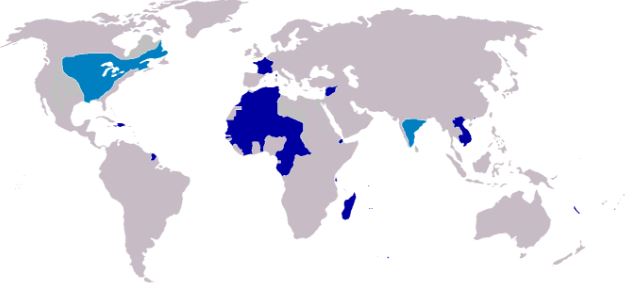
In Africa, it conquered Algeria in 1847. Later, in 1881 it conquered Tunisia, in 1905 it established a protectorate in Morocco against opposition from Germany, an act which was on the brink of leading to a military conflict of international character, and in 1881 the French Congo was declared a colony of the Empire. In the center of the continent, it possessed Senegal, Guinea, the Ivory Coast, Benin, and Chad. In 1898 it obtained Madagascar and later controlled all of the Maghreb, however, it lost influence in Egypt and Sudan, which fell under British dominion.
In Asia, it conquered Burma, Laos, Thailand, Vietnam, Cambodia, and Malaysia; in Oceania, it ruled New Caledonia and other Pacific islands; in the Americas, it possessed Tahiti, the Marquesas Islands, the archipelago of Miquelon in Canada and French Guyana in South America.
28. Carthaginian Empire
Carthage was an important city of Antiquity, founded by the Phoenicians proceeding from Tyre in a coastal settlement in the north of Africa, near the current capital of Tunisia. The classical legend says that it was princess Dido who founded it in the year 814 B.C.

After the decline of Tyre, Carthage developed a great state, of a republican character but with certain monarchical or tyrannical characteristics, which evolved into a fully republican system. The territories controlled by Carthage made it the capital of a prosperous republic, being enriched by the resources coming from all of the western Mediterranean. Carthage was during a long time a city more prosperous and rich than Rome, thanks to the commercial activities that it maintained throughout the Mediterranean.
The Carthaginian Republic confronted the Roman Republic for the hegemony of the western Mediterranean, being totally defeated in the year 146 B.C., which gave place to the disappearance of the Carthaginian Empire and to the destruction of the city of Carthage.
29. Austro-Hungarian Empire
In 1867, after the recognition of the autonomy of the Kingdom of Hungary, the Austro-Hungarian Empire was born with the signing of the so-called “Austro-Hungarian Compromise.” The ruling house came from one of the oldest aristocracies in Europe: the Hapsburgs. A decade later the Turkish territories of Bosnia-Herzegovina and Novi Pazar were annexed to the empire.
The Austro-Hungarian Empire was made up of eleven states in addition to Austria and Hungary: Slovakia, Slovenia, Croatia, Bosnia, Serbia, Montenegro, Romania, the Czech Republic, Poland, Ukraine, and the Italian territory of Trieste.

The empire entered the global panorama when the Archduke Franz Ferdinand, heir of the reigning house of Hapsburg, and his wife Sophie Chotek were assassinated in Sarajevo in an attempt carried out by a Serbian/Bosnian terrorist. The matter became the detonator of the First World War (1914-1918) with the invasion of pro-independence Serbia by the Austro-Hungarian army, with Russian support.
After the end of the First World War, the defeated empire began to decline until capitulation. In 1919 after the signing of the Treaty of Saint-Germain and the Treaty of Trianon, the empire disappeared and in its place the countries of Austria, Hungary, and the Kingdom of Serbs, Croats, and Slovenes were formed.
30. Hun Empire
The Hun Empire was founded by the Huns, an Asiatic people who carried out incursions deep into Europe and Asia as far as India. Their origin is found in Mongolia, which at that time was a confederation of nomadic peoples who based their lives on the care of livestock.
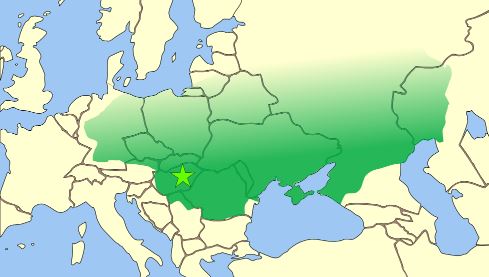
At the beginning of the 5th Century, the Huns, directed by Rua, formed an empire which extended from the Caucasus to the River Elba, thanks to the rapidity with which their horses allowed them to travel. Bleda and Attila, sons of Rua, were his successors. Bleda died, assassinated and Attila, “The Scourge of God,” broadened his dominions through the area of the Balkans in the middle of the century.
Byzantium bought peace, adding to the tribute which it already payed the Huns. In 451, Attila crossed the Rhine River and besieged Orleans. The Gallo-Romans, Burgundians, Alans, Saxons, and Armoricans, led by the Roman general Aetius, obligated him to raise the siege and defeated him at the Battle of the Catalaunian Plains, near Troyes.
The next year, Attila crossed the borders of the north of Italy and arrived as far as Rome, which was able to save itself thanks to the intervention of Pope Leo I and the promise of a tribute. Soon after Attila died and the empire, deprived of his authority, came undone. The Huns ceased to be a threat to Europe and retreated to the steppes of the south of Russia at the end of the 5th Century.
31. Second German Reich
Between 1871 and 1918 one of the most important historic periods took place in Germany: the construction of the Second German Reich beginning with the unification of Germany around the state of Prussia and with the enthroning of Wilhelm I of Prussia as emperor in 1871. This period ended with the proclamation of the German Republic and the abdication of the emperor Wilhelm II in November of 1918.
The true author of the German Empire was the Prussian chancellor Otto Von Bismarck, an authoritarian politician under whom Germany ceased to be a liberal and democratic state, becoming an authentic power after a series of wars against Denmark, Austria, and France in order to recover states which they considered lost. Bismarck unified Germany around the Prussian hegemony and congregating around this Bavaria, Württemberg, and the great duchy of Baden.
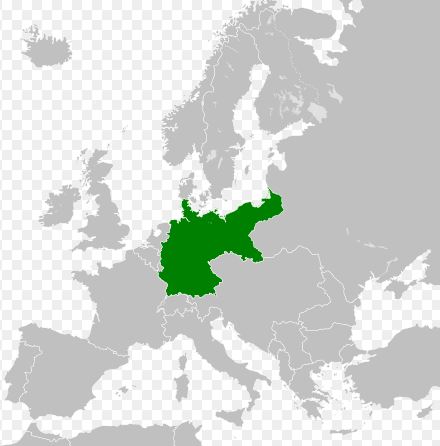
During its 47 years of existence, the German Empire arose as one of the most powerful industrial economies on Earth and a great power, until it was toppled after its military defeat in the First World War and the November Revolution.
32. Carolingian Empire
Three centuries after the disintegration of the Western Roman Empire, Charlemagne reunified part of this territory under Frankish power. He was crowned emperor in Rome by the Pope in the year 800.
The primary objective of Charlemagne was to restore the Western Roman Empire. With this objective he initiated the conquest of neighboring territories, extending his domains from the Atlantic Ocean to the river Elba and from the Baltic Sea to the Pyrenees, evangelizing the conquered peoples with the intended end of making concrete the ideal of a Europe united under only one power and only one faith: the Christian faith.

Under his sword, the Saxons withdrew, situated in the north of Germany, the Avars, who were exterminated, and the Lombards, a Germanic people who inhabited the north of Italy in a place which the Pope Adrian I wanted to recover. These Lombard territories were conceded to the papacy, which started the Papal States, which would be unified with the rest of Italy in 1870.
The Carolingian Empire occupied a border territory near the Pyrenees which it denominated the Spanish March, but it was not able to cross over to occupy Muslim Spain, because of a great defeat suffered at Roncesvalles.
Charlemagne was succeeded by his son Louis in the year 814. He was a weak monarch who had to endure internal conflicts with the nobility and over his own succession, for which his sons competed. In the external order, the empire suffered new invasions between the 9th and 10th Centuries by Viking, Saracen, Hungarian, and Slavic peoples, which made the medieval world highly unstable, beginning to settle the bases of the new feudal organization with strong local powers under the charge of feudal lords and a territory divided into small kingdoms or lordships.
Louis died in the year 840 and after several years of internal conflicts, the Treaty of Verdun was signed in the year 843 which divided the empire into three parts, laying in incipient form the bases of what would be in current Germany, France, and Italy.
The kingdom of the Franks was the most stable and lasting kingdom of those founded by the Germanic peoples in Europe.spanis
